Mastering the basics leads to finer finishes
In looking over some of the correspondence I’ve received from readers of this column for the last seven years or so, I noticed that many of the questions asked can…
In looking over some of the correspondence I’ve received from readers of this column for the last seven years or so, I noticed that many of the questions asked can be answered by reviewing the basics of wood finishing. Among the issues most often raised are: What is the best (finish, topcoat, stain, filler and sandpaper) to use? How do I (perform some task)? What went wrong?
I might have to ask for more detail about the finisher’s knowledge or experience, about what was actually done or the desired outcome but, again, my eventual reply will often involve getting back to the fundamentals.
Proper prep work
Proper preparation of the surface is the first step in the actual finishing sequence. The best, most expensive or most popular coating product and process can fail if applied over a wet, dirty, greasy, chalking, flaking or otherwise compromised surface. Wood surfaces should not be too rough or too smooth and should be finish-sanded the same day that the first coating material is applied.
Material handling
The finishing materials that will either be applied to the object as part of the coating, such as dye stain, pigmented stain, grain filler, sanding sealer, glaze, toner, distressing and topcoat, as well as any thinner, reducer, retarder, sheen adjustment product, flow enhancer or other additive should be compatible as a system. They should be selected to meet the needs of the finisher and the product to be finished. They should be in good condition and within their shelf-life parameters. Bear in mind that many products can deteriorate rapidly if stored under conditions of high or low temperature. The published shelf life can also be affected by poor practice that allows solvents to escape or contaminants to enter the package.
For example, using varnish directly from a large container allows much more exposure of the varnish to oxygen and greater evaporation of the solvents than decanting only the amount of varnish that will be used in a short time and resealing the larger container. The varnish in the larger container repeatedly exposed to oxygen and evaporation will deteriorate much faster.
Some materials will separate in the can over time and might or might not be easily recombined. A pigmented stain that sits on the shelf for three years between uses could settle hard and require extensive agitation to break up the packed pigment and resin solids sufficiently to be useable.
While a straight nitrocellulose lacquer can perform well after being stored for several years, a precatalyzed lacquer might lose some of its performance, especially if stored in higher temperatures, over a much shorter time. Waterborne products can lose performance if allowed to freeze.
It is easier to ensure compatibility if the products are from the same manufacturer and easier to get technical help for problems. Generic equivalents are not always truly equivalent.
Application equipment
Whatever you choose to use for applying the coating to the surface (rag, brush, roller, air spray, HVLP, air-assisted/airless), your tools should be clean, well-maintained and properly set up for the coating you are using. The airless sprayer you used to paint your house might do OK spraying lacquer, but you’ll probably need a different tip size.
If you are using a compressor, make sure that it is regularly drained of water, the filters are in good condition, the air hose is not worn or kinked and it is set to deliver sufficient air for the pump or spray gun.
Skills and training
The first week driving a car by myself, I backed over a 12-foot-tall magnolia tree my mother had nursed for four years. I had some training, but not much skill. Don’t expect to develop skill without practice and remember that some training can speed up the development of the skill. While the Internet can’t replace hands-on training, it can be a valuable resource. Before tackling a big project, hone your skills on practice pieces or sample panels. Producing a step panel for the project before starting on the actual finishing of the item is a good way to avoid surprises and disappointment.
The right conditions
The immediate environment in which you apply the coating greatly affects the result. Airflow into and out of the area is necessary not only for the safety and comfort of the operator, moving solvents and particulates out of the area, but also for drying of the film and avoiding dust accumulation on the surface.
Airflow should be of sufficient velocity and volume, clean and dry. The temperature should be between 65 to 90 degrees and relative humidity between 35 to 50 percent. An airflow velocity of 100 feet per minute is often required to meet regulatory mandates, but the airflow should be powerful enough to move the solvent and particulate as described, but not so fast as to materially deflect the spray pattern from the gun, dry the coating too quickly or evaporate the solvents too quickly.
The volume is the amount of air, measured in cubic feet per minute, exchanged by the exhaust system. The National Fire Protection Association requires that this volume be sufficient to dilute the solvent concentration in the area to below 25 percent of the lower flammable limit. While equipment is available to test the concentration, computing the volume at a velocity of 100 fpm is usually sufficient.
At the time of coating application, the material should be at the proper viscosity and temperature. Viscosity decreases with an increase in the temperature and increases with a decrease in temperature. Higher viscosity can cause poor atomization, orange peel and poor flow out. Too low a viscosity can lead to runs, puddling, lower transfer efficiency and film build. Too high a temperature of the air or the material can accelerate the drying, increasing the likelihood of dry overspray accumulating on the object causing a rough, textured surface.
Similarly, the temperature of the object to be coated should be within the specified range. Too high a temperature can cause pinholes or blistering of the film. Too low a temperature of the object or material can contribute to blushing, cold checking, slow drying, incomplete curing, blocking, soft surface and uneven gloss.
Relative humidity is the percentage of moisture in the air relative to the amount of moisture that could be held as vapor in the air at a given temperature. For instance, if the air is holding 50 percent of the maximum vapor possible at 70 degrees, the relative humidity is 50 percent. As the air cools, the maximum amount of water vapor it can hold falls. With sufficient cooling, the temperature can fall below the dew point (the temperature at which the amount of moisture in the air goes above 100 percent of capacity) causing moisture to precipitate out of the air.
When spraying an evaporative coating like lacquer, the evaporation of solvents has a cooling effect on and above the surface of the object. Should the temperature drop below the dew point, that moisture precipitating can react with the lacquer, causing a cloudy whitening of the surface.
In high-humidity conditions it is common to slow down the drying of the surface with a blush eliminator or retarder. This can also be accomplished by making the air, coating and object to be finished 10 degrees warmer than the room’s ambient temperature.
Your spray booth should also be configured to provide sufficient and appropriate lighting — both ambient and task — for the operator. If color matching is required, the color temperature and Color Rendering Index should be considered. Light should illuminate, without shadows, the surface at the point where the liquid coating contacts the surface of the object so that the operator can clearly see the wet edge as it is forming. The industry standard for booth lighting intensity is 100-foot candles 3’ above the work surface.
Greg Williams, formerly senior touchup and finishing instructor for Mohawk Finishing Products, is now a freelance instructor and consultant.
This article originally appeared in the June 2016 issue.






